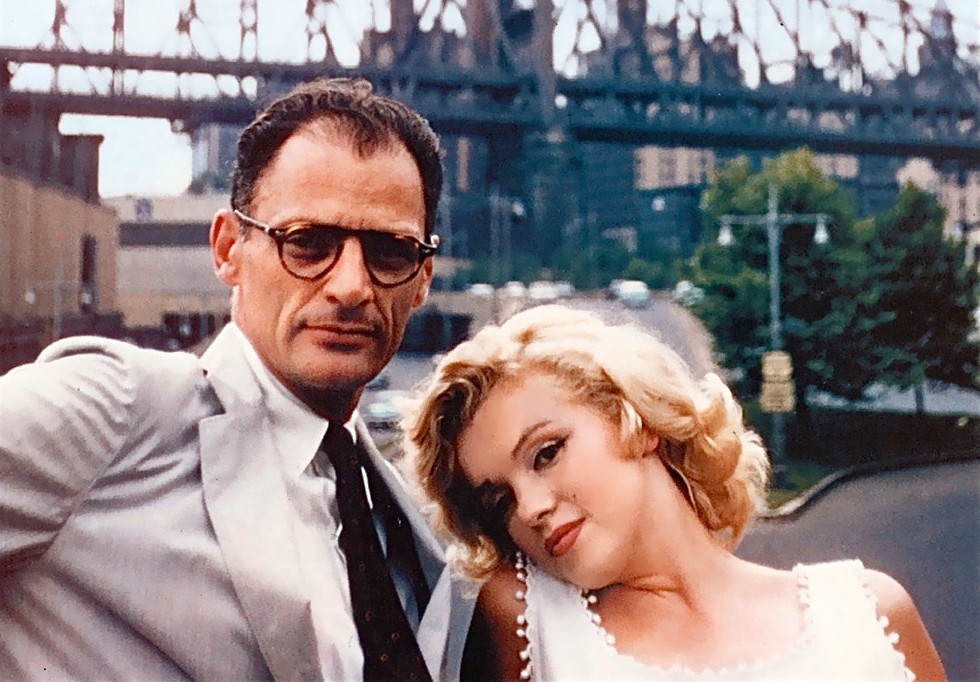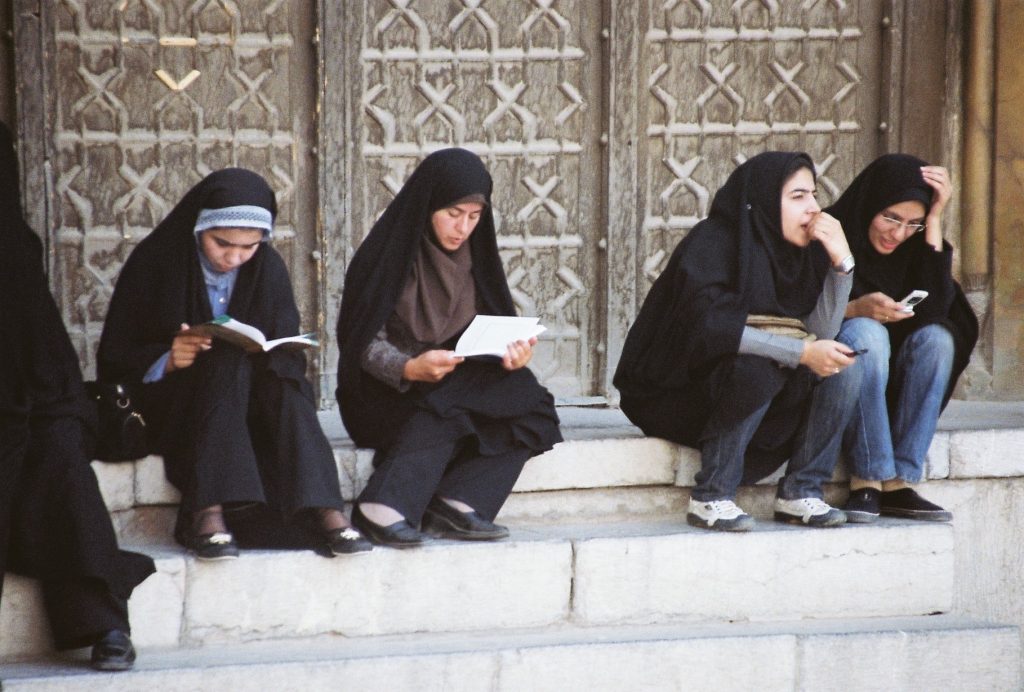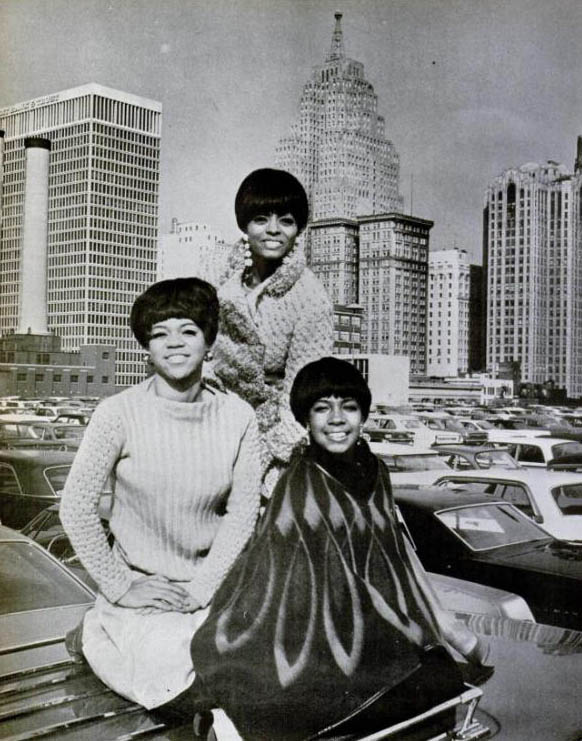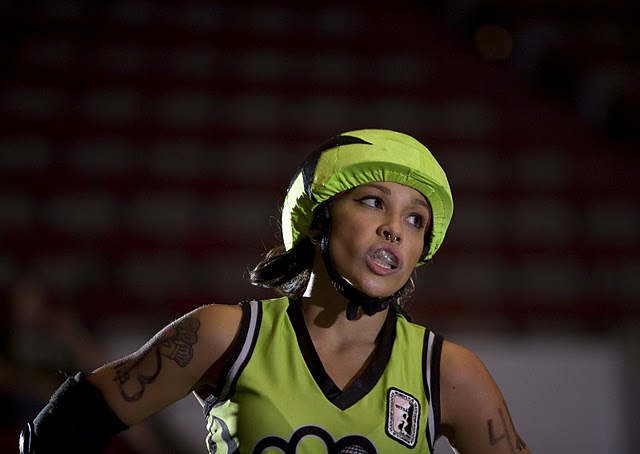“Marilyn and the Literati,” by Jeffrey Meyers, appeared in MQR’s Winter 2008 issue.
*
Talking about poetry readings, Robert Frost was fond of saying, “I only go if I’m the show.” Unwilling to share the limelight with any other poet, Frost cultivated his own public image. Celebrities love to be seen with other celebrities—it generates more publicity and enhances their own celebrity status—but a movie star’s fame always trumps a writer’s. When Marilyn Monroe moved from Hollywood to New York to take lessons at Lee Strasberg’s Actors Studio, the local literati, eager to bask in her reflected glory, all wanted to meet and mix with her. Writers soon learned the art of using and being used, the celebrity dance of being famous together. Marilyn made dramatic appearances at El Morocco, the Colony, and the Plaza Oak Room with Truman Capote and kicked off her shoes while dancing with him so that (at 5’5″) she wouldn’t be a head taller than her dwarfish consort. She also accompanied Carson McCullers and Tennessee Williams’s mother to a party at the Saint Regis Hotel to celebrate the opening of Cat on a Hot Tin Roof.
Everyone wanted to know what Marilyn was really like. Was she beautiful or vulgar? Genuine or artificial? Sexy or sluttish? Witty or just dim-witted? She had grown up poor and uneducated, unloved and preyed upon, and was now a deeply wounded and emotionally vulnerable young woman. In the fall of 1954 she was twenty-eight years old, in the first phase of the extraordinary fame that became legendary after her death in 1962. Dissatisfied with her dumb-blonde roles at Twentieth Century–Fox, off salary and short of money, she had escaped to New York. She was also fleeing an unhappy marriage to another celebrity, Joe DiMaggio, which lasted only nine months. Baffling and infuriating the studio heads, she said she wanted to learn her craft and educate herself. The intellectuals were happy to oblige.
Keen publicists and magazine editors looking for sure-fire copy encouraged incongruous, absurd, and potentially contentious encounters between Marilyn and highbrow authors she’d never read—nor even heard of. Yet she established a natural affinity with many writers who were, like herself, eccentrics and outsiders, heavy drinkers and drug-takers. Weary of being a sex object, she desperately longed for “someone to take me out who doesn’t expect anything from me.” She felt more at ease with homosexuals—like Capote and Williams. Later on she found Montgomery Clift, her costar in The Misfits, a perfect companion. He had no sexual designs on her, no perilous pounce. Filled with self-doubt and neurotic fears, dependent on painkillers and alcohol, he was, Marilyn observed, “the only person I know who’s in worse shape than me.”
Marilyn met Carson McCullers (who was nine years older) in 1954 when they were both staying at the Gladstone, a small, stuffy apartment-hotel on East Fifty-second Street, off Park Avenue. McCullers had had a stroke and lurched around with a cane. Like Marilyn, she drank heavily and gulped down barbiturates, tried to kill herself, and did time in the Payne-Whitney mental clinic. Her biographer Virginia Carr wrote that “according to Carson, Miss Monroe had wonderfully admirable attributes.” Though Carr did not define these qualities, they included human warmth and the capacity for friendship.
In February 1959, when the seventy-four-year-old Danish author Isak Dinesen—wasted, skeletal, and ravaged by syphilis—expressed a desire to meet Marilyn and her husband, Arthur Miller, McCullers invited the actress and playwright to lunch at her house in Nyack, New York. She served oysters, white grapes, soufflés, and champagne on a black marble table. Carr noted that “Monroe, who had a marvelous sense of humor and whom the guests found charming, entertained the group with an anecdote from her own kitchen. She told with much cleverness a tale on herself involving some homemade noodles she had tried to create one night for her husband like his mother [who was born in America] used to make in the ‘old country.’ The conglomeration was such a failure that she was afraid she had lost not only a meal, but a husband.” Dinesen’s biographer Judith Thurman added an amusing detail to Marilyn’s story: “it got a little late, the company was arriving, and the pasta wasn’t ready, so she tried to finish it off with a hair dryer.”
Referring to Dinesen by her familiar name, McCullers described how Miller questioned Tanya rather pedantically about her strange diet and received for his pains a stern rebuke: “Tanya ate only oysters and drank only champagne. . . . Arthur asked what doctor put her on that diet. . . . She looked at him and said rather sharply, ‘Doctor? The doctors are horrified by my diet but I love champagne and I love oysters and they agree with me.’ . . . Arthur mentioned something about protein and Tanya said, ‘I don’t know anything about that, but I am old and I eat what I want and what agrees with me.’ Then she went back to her reminiscences of friends in Africa.”
McCullers’s memoir gives the flavor of this bohemian gathering. She recalled that her own black help reminded Dinesen of her African servants: “It was a great delight for her to be with colored people. Ida, my housekeeper, is colored, and so are my yardmen, Jesse and Sam. After lunch everybody danced and sang. A friend of Ida’s had brought in a motion picture camera, and there were pictures of Tanya dancing with Marilyn, me dancing with Arthur, and a great round of general dancing.” In her account Marilyn seems happy—talking freely, making fun of herself, and enjoying the affection and attention of two eminent ladies.
Thurman mentioned that Tanya “was photographed in New York with Marilyn Monroe, and that image was more ‘typical’ of the old Isak Dinesen: twisted smile, elegant gray suit, head swathed in a turban, body muffled in a fur.” Dinesen’s account of Marilyn’s appearance and character shows that she understood, better than McCullers, Marilyn’s complex and disturbed personality. Using words like “incredibly” and “unbelievable” as if to emphasize Marilyn’s hyperreality, but with a novelist’s insight, she compared her to an apparently harmless but quite dangerous wild animal. “It’s not that she is pretty,” she said, “although of course she is almost incredibly pretty—but that she radiates at the same time unbounded vitality and a kind of unbelievable innocence. I have met the same in a lion cub that my native servants in Africa brought me. I would not keep her.” Underlying her beauty and apparent innocence, which fascinated Arthur Miller and everyone else, was the traumatically damaged orphan.
Like McCullers and Dinesen, the English poet Dame Edith Sitwell, grotesque at sixty-six, was a perfect foil for Marilyn’s youthful perfection. As strange as Dinesen, but adorned with an even more elaborate turban, Sitwell was six feet tall, pale-faced and lank-haired, with a distinct curvature of the spine and a long curved nose that resembled an anteater’s. The daughter of a wealthy coal magnate, Sitwell claimed descent from the Norman conquerors. Disdaining her work, the critic F. R. Leavis remarked that she belonged “to the history of publicity rather than that of poetry.” True to form, when she visited Hollywood in February 1954 she also wanted to meet Marilyn. Life magazine, mistakenly convinced that the two women “were born to hate each other, and that their insults to each other ‘would cause a commotion when reported,’” brought them together. But Sitwell found her serious-minded and pleasantly shy—that is, suitably intimidated and deferential. They actually had something in common. Sitwell’s shallow pretensions and Marilyn’s naïve search for meaning in life came together as they talked about the “spiritual doctrines” of the crankish Hungarian anthroposophist, Rudolf Steiner.
When Sitwell returned to England early in 1955, she was annoyed to discover that journalists wanted to talk only about Monroe. Ignoring the fact that she was the one who wanted to meet Marilyn (who, of course, had never heard of her) and irritated that Marilyn had upstaged her, Sitwell relegated her to the common herd. She imperiously exclaimed: “I am not bringing Miss Marilyn Monroe to England. Is it supposed that I am a publicity agent or a film agent or a press agent? . . . Miss Monroe, like a good many other people, was brought to see me while I was in Hollywood. I thought her a very nice girl, and said to her as I said to others, that if she came to London she should let me know and should come to a luncheon party. There the matter began and ended.”
Surprisingly enough, they did meet again, in 1957, when Marilyn came to London to make The Prince and the Showgirl with Sir Laurence Olivier. Sitwell’s biographer Victoria Glendinning described their rather prosaic luncheon at the Sesame Club: “this time Miller and Edith did the talking, while the star sat and listened. The party was spoiled by the intrusion of overexcited photographers and journalists.” In his account of the same meeting, Marilyn’s biographer Donald Spoto eliminated Miller. He dramatized the encounter and added exotic costumes, bountiful alcohol, and poignant lines of poetry:
[Sitwell] welcomed Marilyn to her home [i.e., her club] in October. Wearing her usual array of rings on each finger, a medieval gown, a Plantagenet headdress and a mink stole, Dame Edith sat grandly, pouring hefty beakers of gin and grapefruit juice for herself and her guest. During several hours one afternoon, they sat discussing Gerard Manley Hopkins and Dylan Thomas, whose poems Marilyn was reading during sleepless nights that season. For Dame Edith, Marilyn recited lines from one of Hopkins’s Terrible Sonnets—“I wake and feel the fell of dark, not day [/ What hours, O what black hours we have spent / This night”]—saying that she understood perfectly the poet’s mood of despair. “She’s quite remarkable!” pronounced Sitwell soon after.
But even the self-absorbed Sitwell could not miss Marilyn’s profound unhappiness and insecurity. She told reporters that the mild-mannered actress had known great poverty and reminded her of a teenaged child who had been forced to fend for herself. Sitwell’s final judgment was both naïve about Marilyn’s recklessly self-destructive sexual life (the virginal poet lacked carnal knowledge) and, with hindsight, poetically prescient about her tragic death: “She was very quiet and had great natural dignity (I cannot imagine anyone who knew her trying to take a liberty with her) and was extremely intelligent. She was also exceedingly sensitive. . . . In repose, her face was at moments strangely, prophetically tragic, like the face of a beautiful ghost—a little spring-ghost, an innocent fertility-daemon, the vegetation spirit that was Ophelia.”
In the spring of 1956 Saul Bellow spent six weeks next door to Arthur Miller when they lived in isolated cabins in the Nevada desert, waiting for their divorces. But he did not meet Marilyn, who bagged her literary lion and married Miller in June that year. In 1959 (after their first meeting) Bellow had his own opportunity to pay tribute to the goddess of the cinema when he had dinner with Marilyn, in Chicago for the premiere of Some Like It Hot, at the Ambassador East Hotel. Bellow was intrigued by the details of her life, and admired the way she dealt with the intrusive demands of publicity. He found “the star surrounded by an entourage that included a manicurist and a bodyguard, who left the door open when he went to the bathroom. ‘He’s not supposed to let me out of his sight,’” Monroe explained. After dinner at the Pump Room, she signed the guest book, “Proud to be the guest of the Chicago writer Saul Bellow.” In a star-struck letter to his editor Pascal Covici the next day, Bellow reported: “Marilyn seemed genuinely glad to see a familiar face. I have yet to see anything in Marilyn that isn’t genuine. Surrounded by thousands, she conducts herself like a philosopher.” Bellow, who had an eye for women and married five times, spoke rapturously of the golden glow of her skin. He must have been besotted, indeed blinded, to find Marilyn, all tarted-up Hollywood artificiality, as “genuine.” In recent years she’d suffered a miscarriage and several nervous breakdowns. She’d attempted suicide and made Miller’s life a misery.
Marilyn had always hero-worshipped Abraham Lincoln and, when she first met the tall, lean Miller, was fond of comparing him to the upright president. Lincoln’s biographer, the monkey-faced Carl Sandburg, had left school at thirteen and tried many proletarian jobs before becoming a poet and writer. Much anthologized, Sandburg was a beloved if limited poet, a fixture of the fifties. Robert Frost, always annoyed, even infuriated, by the way Sandburg combed his long silky hair into his eyes, exclaimed: “You know the way he dresses, that hair of his and those [string] ties. Everything about him is studied—except his poetry.”
The eighty-one-year-old Sandburg met Marilyn in 1958, during the filming of Some Like It Hot, and sometimes visited her New York apartment for informal literary tutorials. Donald Spoto wrote that “he found her ‘warm and plain’ and charmed her by asking for her autograph. ‘Marilyn was a good talker,’ according to Sandburg, ‘and very good company. We did some mock playacting and some pretty good, funny imitations. I asked her a lot of questions. She told me about how she came up the hard way, but would never talk about her husbands.’” The lonely old man and lonely young woman were photographed doing healthy exercises and drinking champagne.
After her suicide Sandburg was interviewed in Look magazine. The reporter described Sandburg’s “longish white hair flapping like skeins of corn silk” and noted that Marilyn had bonded with the poet by bleaching her platinum blond hair “the exact shade” of his. In a string of reassuring banalities posing as pearls of wisdom, Sandburg said she was “a great actress,” “had a genuine quality” and “had some faith in me.” Though Marilyn, a chronic insomniac, “had a hard time with her sleep,” he “saw no signs of despondency” and felt, reasonably enough, that six is just too young to die.” Sandburg, ever the smiling public man, ignored the dark side of her personality.
In 1958 Marilyn had done her best work in Billy Wilder’s Some Like It Hot, but remained neurotically insecure about her talent. She couldn’t remember her lines, was notoriously late, and forced the director and fellow actors to endure many costly and exasperating delays. The studio still regarded her as its property. When Nikita Khrushchev visited Twentieth Century–Fox in September 1959, president Spyros Skouras saw it as a great photo opportunity, a contrast between beauty and the beast. He told Marilyn to wear her tightest, sexiest dress and invited her to sit at the main table in their lavish commissary. For the first time in her life Marilyn arrived early, and Billy Wilder said Khrushchev ought to direct her next picture. When Skouras told his oft-repeated story of how he had progressed from poor immigrant to studio head, Arthur Miller wrote, Khrushchev “countered that he was the son of a poor coal miner and was now the head man of the whole Soviet Union. Marilyn thought that [was] a fantastic reply; like her, Khrushchev was odd man out.” Skouras presented her to Khrushchev “as a great star. The Soviet chairman was obviously smitten with her, and she in turn liked him for his plainness.”
They chatted through an interpreter about The Brothers Karamazov, whose heroine, Grushenka, she’d wanted to play on stage (because “she’s a girl,” Marilyn helpfully explained). She seemed eager to accept Nikita’s invitation to visit Russia and have a tête-à-tête in the Kremlin. Gratified by her ability to charm, she later told her maid that she’d impressed the repulsive, bone-crushing premier, who’d been brought up on Soviet propaganda films featuring muscular heroines of industrial labor: “I could tell Khrushchev liked me. He smiled more when he was introduced to me than for anybody else at the whole banquet. . . . He squeezed my hand so long and hard that I though he would break it. I guess it was better than having to kiss” the man who was “fat and ugly and had warts on his face and growled.” Marilyn, who’d done her share of couch-casting during her early years in Hollywood, knew quite well what it was like to kiss disgusting old men. Even at the peak of her career her beauty remained a prize to be bandied about and flaunted before a visiting dignitary.
John Huston had introduced Truman Capote to Marilyn when she was making her first important film appearance, in The Asphalt Jungle (1950), and she contacted him when she first arrived in New York. Two years older than Marilyn, he shared her addiction to drink and drugs. Ever the publicity hound, Capote styled himself her friend, and said he wanted Marilyn (not Audrey Hepburn) to play Holly Golightly in Breakfast at Tiffany’s. With typically disparaging wit he declared that her marriage to Miller should be called Death of a Playwright. After her death he wrote two crude, self-serving and denigrating essays about Marilyn in The Dogs Bark (1973) and Music for Chameleons (1980).
His chapter on Marilyn Monroe calls her “Just a slob, really” and describes her vulgar mannerisms: “her slippery lips, her overspilling blondness and sliding brassiere straps, the rhythmic writhing of restless poundage wriggling for room inside roomless décolletage—such are her emblems.” He loathes the very quality, her lush femininity, her public so admired. He concludes, with pop psychology and bogus religious imagery, that “she is stained, and illuminated by, the stigmata of orphan-thinking”; that the depth of her anxiety, “her frequent sore-throated indispositions, her nibbled nails, her damp palms, her Japanese-like fits of giggling induces a butter-hearted sympathy.” Capote clearly saw her orphan’s desperate desire to be liked, but had no sympathy for her.
An outrageous liar who liked to smear straight men, Capote used his second essay on Marilyn to spread obscene scandal about Errol Flynn. In Capote’s malicious tale, Marilyn claims that she saw Flynn publicly playing a piano with his penis. Flinging more mud at Flynn, Capote falsely claimed that in 1943 he had had a one-night stand with Flynn. The title of this essay, “A Beautiful Child,” comes from Marilyn’s sometime acting teacher Constance Collier, who rightly said, “This beautiful child is without any concept of discipline or sacrifice.” Capote has Marilyn exclaim, “I like to dance naked in front of mirrors and watch my titties jump around.” When she confronts a dimly lit mirror and he asks, “What are you doing?,” she cryptically replies, “Looking at Her.” But he does not connect the two mirror scenes, nor explain that though her tits were reassuringly real to her, her identity was not.
Capote had called Marilyn a slob in his first essay and he felt obliged to repeat it in the second. Still searching for her true identity, she remarks, “if anybody asked you what I was like, what Marilyn Monroe was really like—well, how would you answer them? . . . I bet you’d tell them I was a slob.” In contrast to all the other writers, Capote portrays a Marilyn unsure how to dress, spooked by death, childishly narcissistic, confused about her own true self, and a vulgarian. Like many of her “friends,” in life, Capote exploited her to publicize himself. After her death, when his career was failing, he turned her into cheap copy.
Marilyn was a kind of touchstone for writers. Unsure of her own identity, she identified with others. She was warmly responsive to those who showed an interest in her, and the best authors appreciated her human qualities. The Russian novelist Vladimir Nabokov was as handsome and sophisticated as Nikita Khrushchev was coarse and crude. He met Marilyn at a Hollywood party while he was working on the screenplay of Lolita in the spring of 1960, and examined her as if she were one of his exquisite butterflies. Stacy Schiff wrote that “in Vladimir’s recollection, ‘She was gloriously pretty, all bosom and rose’—and holding the hand of [her current lover] Yves Montand. Monroe took a liking to Vladimir, inviting the [Nabokovs] to a dinner, which they did not attend.”
Nabokov didn’t care about Marilyn’s publicity value. But he saw her with a shrewd novelist’s eye and imaginatively recreated her in two novels: Ada (1969) and Pale Fire (1962). Ada’s absurd lessons from Stan Slavsky, based on the influential Russian actor and teacher Konstantin Stanislavsky, satirized Marilyn’s rather futile lessons in the Method at the Actors Studio. In the title poem of Pale Fire, Nabokov celebrated Marilyn’s “bloom and rose.” The last line’s “corporate desire” puns on the public lust for her sensual body and the dominant studio that controlled so much of her life:
The famous face flowed in, fair and inane:
The parted lips, the swimming eyes, the grain
Of beauty on the cheek, odd gallicism,
And the soft form dissolving in the prism
Of corporate desire.
The publicists were wrong to assume that Marilyn would collide with rather than get on with celebrities. Though some of them tried to use her, she preserved her sincerity and goodwill. With characters as different as Khrushchev and Nabokov, eccentrics as strange as Dinesen and Sitwell, addicts as troubled as McCullers and Capote, intellectuals as antithetical as Bellow and Sandburg, Marilyn—always searching for her identity, her real self—knew how to establish immediate rapport through her personal warmth and intuitive sympathy.
*
Lead image: Marilyn Monroe and Arthur Miller.




